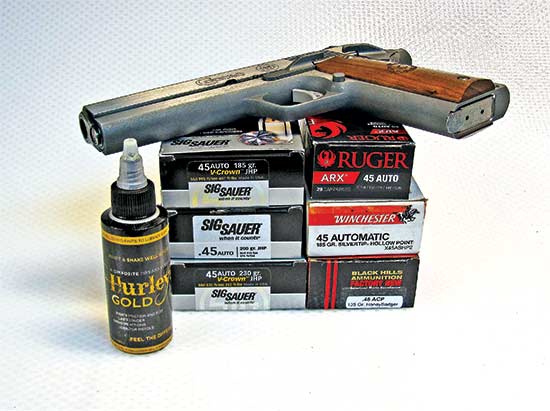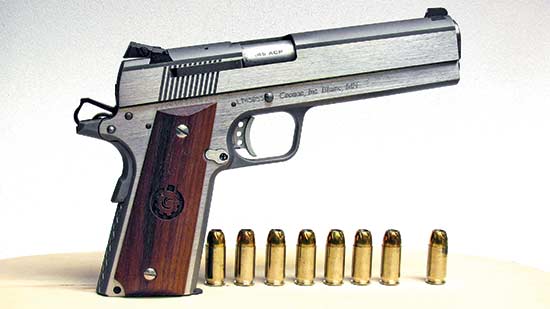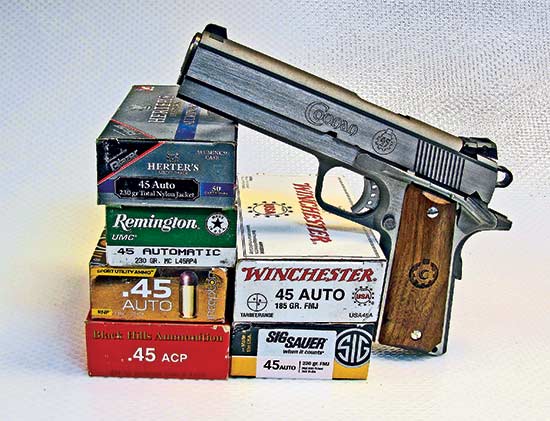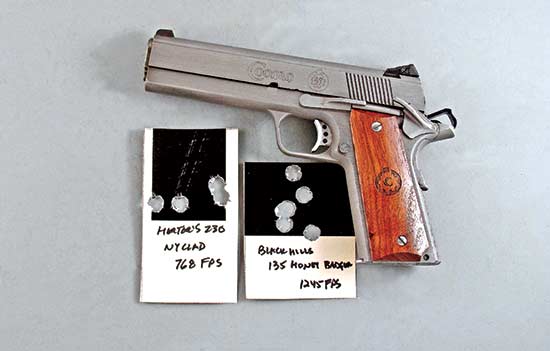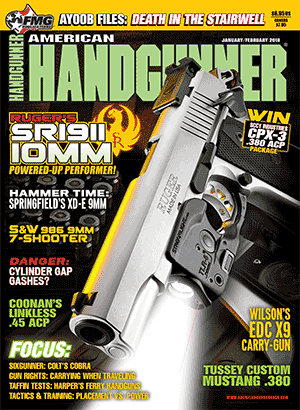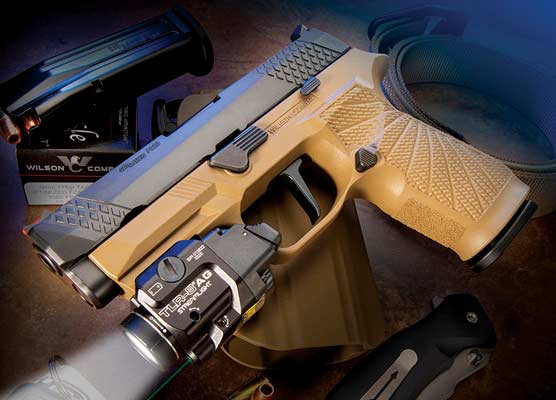Coonan .45 ACP "MOT"
1911 Style — Linkless Design!
Have you ever wondered where firearms manufacturers come up with the names for their handguns? Holding focus groups, maybe even holding a contest among employees to get the best possible name or asking customers to come up with a name are the most common. But to me the most ingenious way to come up with just the right name is what Coonan did to label their linkless .45 ACP.
This particular Coonan’s Model name is “MOT.” I tried to figure out from looking at their website as well as the owner’s manual what in the world “MOT” stood for. Finally I contacted David Dietz, the director of marketing at Coonan. I found his answer very funny. “As you may be aware, we are a very small company and quite informal as a result. There is a 120-pound German Shepherd roaming the front administration office area and he belongs to Greg and Connie White who are the CEO and office manager. This dog is a cuddly sweetheart to all he knows, but when someone comes to the door he doesn’t recognize, let’s just say his bark goes down two octaves and his volume increases several decibels, achieving the true guard dog effect. When working on the new pistol, we realized we needed a model designation for all our new standard 1911-sized frames. Of course it needed to be another TLA (Three Letter Acronym) as is the convention in our industry. We all wracked our brains attempting to come up with something very clever or very descriptive or ideally — both. Well, we gave up on the idea. The German Shepherd’s name is Motley and so was born the new platform name, the Coonan MOT. Now in .45 ACP!” Now that’s real ingenuity!
A Different Path
Coonan’s ingenuity goes past the name they chose. Everybody, and I mean everybody produces 1911’s. I would never have believed 30 years ago we would ever see 1911’s coming from Ruger, Smith & Wesson and Wesson Firearms. To this list we can add dozens more. They’re all different and yet they have one thing in common. They operate on the original John Browning design with the barrel having a movable link.
Coonan took a different path — the link is gone. Sometime way back, I believe it was in the 1980’s, I had a couple test guns produced in Europe which were linkless, but they simply did not work. And for all this time I don’t know of anyone else who had tried a .45 on the 1911 pattern without the original link design. But Coonan has done it and it works.
Coonan’s original semi-auto pistol is in .357 Magnum. With this longer cartridge it was necessary to have a different grip design, however with the .45 they’ve gone back to the more familiar 1911 grip size. Coonan points out three features on their .45 not found, at least normally, on other 1911’s. Gun manufacturers, and especially custom gunsmiths, have been arguing for decades about which is the better extractor design, internal or external. It’s Coonan’s theory the external extractor improves reliability of both cycling and ejection. I can say in all the test-firing there were no problems with either operation with everything from my light-recoiling “Old Man” loads to factory 230 hardball. Coonan does not use a typical leaf spring with their external extractor but rather a coil spring, which not only has a longer life but also provides for more positive extraction.
Another Coonan change is in the trigger design. Most 1911 triggers come straight back, however, the Coonan trigger is on a pivot. Their theory here is a more consistent trigger pull. This trigger is wide and smooth, just the way I like it, and is of the skeletonized style with three holes drilled. And of course the third feature is the 5″ standard 1911-length barrel — but linkless. The link all of us are used to seeing on the back of the barrel serving the purpose of locking the barrel into the slide/frame is not to be found. It’s instead been replaced by a solidly attached groove under the barrel. The theory here is it increases accuracy and reduces feeding problems. The lockup also remains more consistent for a longer period of time. In my test-firing there were no problems whatsoever with feeding any of the ammunition used and accuracy turned out to be excellent.
The Coonan MOT is of all-stainless steel construction with the classic .45 1911 look. The three-dot Novak-style sights are fully adjustable and the low riding rear sight is set in a dovetail. Not only are they easy to pick up with the three white dots, both the front and rear sights are sloping and serrated to reduce glare. The front sight is also set into a dovetail. The slide has cocking serrations that are slanted and placed below the rear sight, the hammer is Commander-style, and both the slide lock and thumb safety are extended and easily reached and operated. The now-mandatory beavertail grip safety and memory bump prevent the top of my hand from being irritated by recoil and also make sure the safety is depressed when I grip this .45. Grips are smooth walnut with the Coonan logo, and the whole package, with two traditional 7-round magazines, comes in a padded black-zippered bag.
Reliable And Accurate
For test-firing the Coonan .45 MOT I used both favorite handloads and factory loads. My easy recoiling “Old Man” loads consist of the Oregon Trail 200 RNFP over 4.0 grains of Bullseye. This easy shooting load clocks out at 720 fps and puts five shots into 1″ at 20 yards. Switching to their 200 SWC bullet gives the same basic velocity with groups just over 1″.
Of all the factory loads tried the best results were with the SIG SAUER 230 FMJ at 850 fps and a 11/4″ group. The newest designed bullets out for self-defense are those that look like the tip of a Phillips screwdriver point. Black Hills offers their Honey Badger 135-grain bullet of this design and it performs exceptionally well, clocking out at 1,250 fps and a 5-shot 13/8″ group at 20 yards. Tests I have seen of this bullet in gelatin are very impressive and these may well be one of the top choices for self-defense use. The Winchester 185 FMJ at 900 fps also shot very well with the same size groups as the Honey Badger.
At about $1,400 MSRP for the basic models, it’s about what a high quality “factory” 1911 costs these days. From those first, early .357 models, to today’s .45, it’s great to see this “classic” name not only still with us — but growing!

